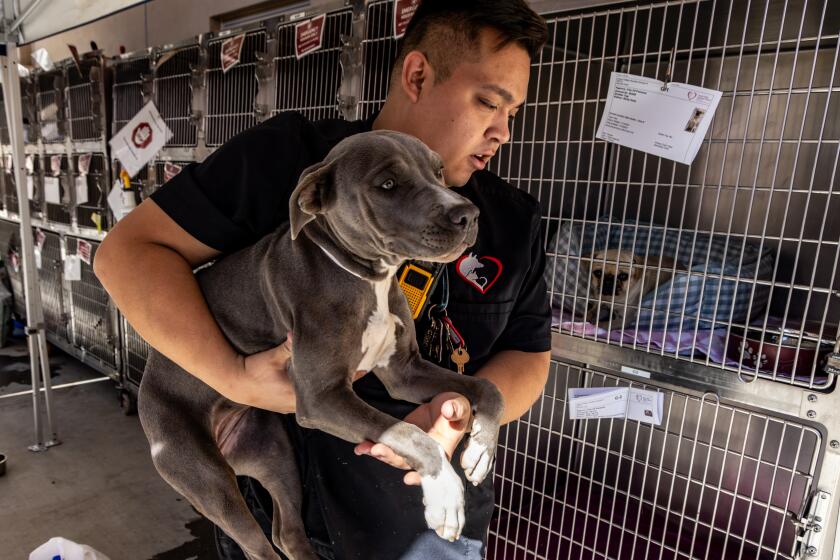Dog rescuer Alyssa Benavidez recorded videos of Pickles, who was staying at the Palmdale animal shelter. Days after Benavidez posted these videos, Pickles was euthanized.
- Share via
When she met a jagged-eared German shepherd puppy named Pickles at the Palmdale Animal Care Center, rescuer Alyssa Benavidez thought the former stray was being overlooked by adopters and wanted to find him a home.
To draw attention to the playful 10-month-old, Benavidez recorded videos of Pickles to post online — in a red bandanna with heart designs, rolling on his back for belly rubs, a red rose rope toy in his mouth.
The shelter, though, did not give her a deadline when she emailed to ask how much time she’d have to work on his exit plan before he would be put down.
A day after her inquiry, on Valentine’s Day, Pickles was euthanized.
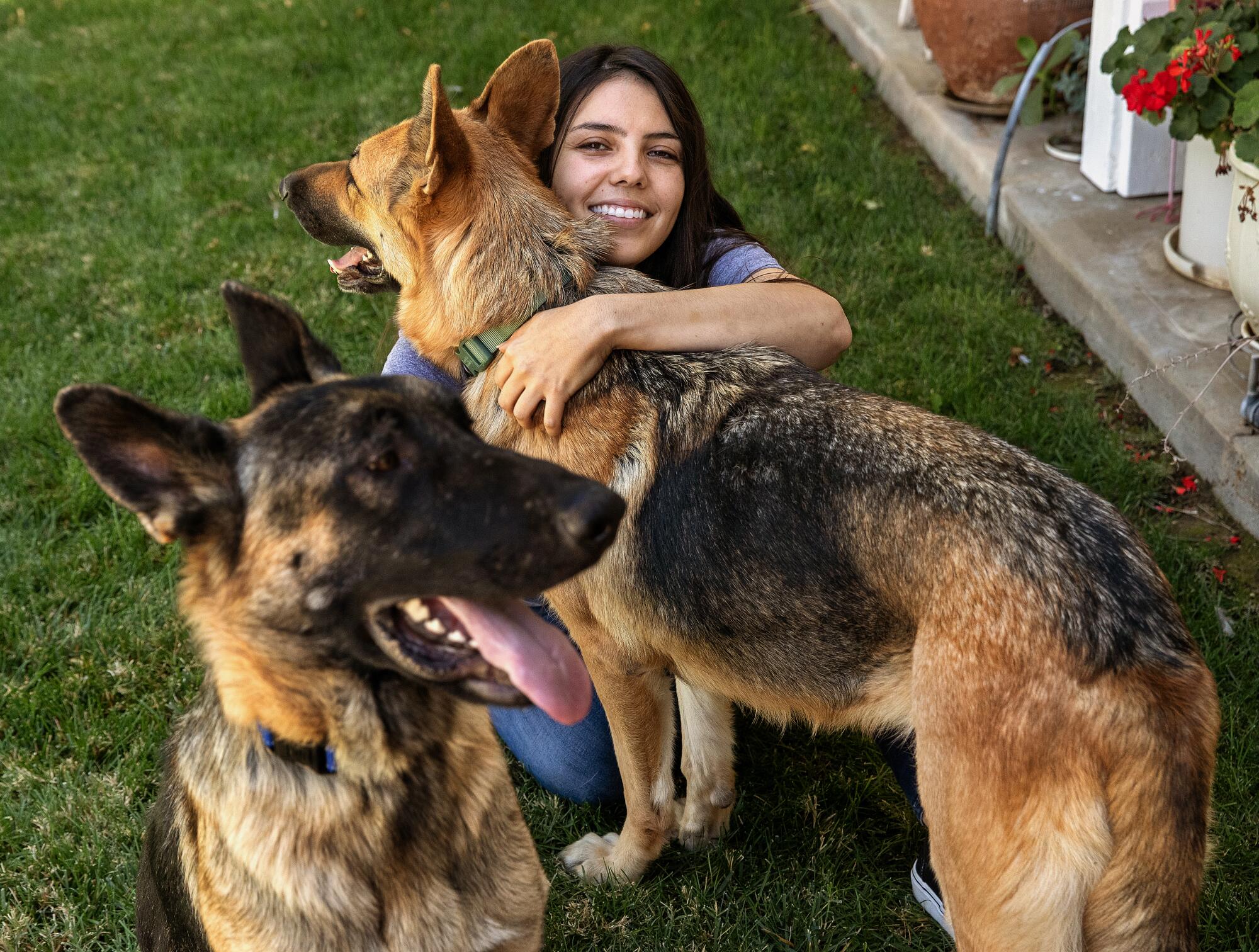
The Palmdale shelter, the newest of seven run by Los Angeles County, was touted when it opened in 2016 as a state-of-the-art facility that would relieve overcrowding and reduce the number of dogs being euthanized at the nearby Lancaster shelter.
But the two shelters now euthanize more dogs — and at a higher rate — than other county facilities, as well as those operated by Los Angeles, Long Beach and other municipalities, a Times investigation found.
Together, the Palmdale and Lancaster shelters’ dog euthanasia rates have nearly doubled in recent years — from about 15% in 2018 to 28% through this August. They’re on track this year to kill dogs at nearly twice the average rate of the other five county-run facilities.
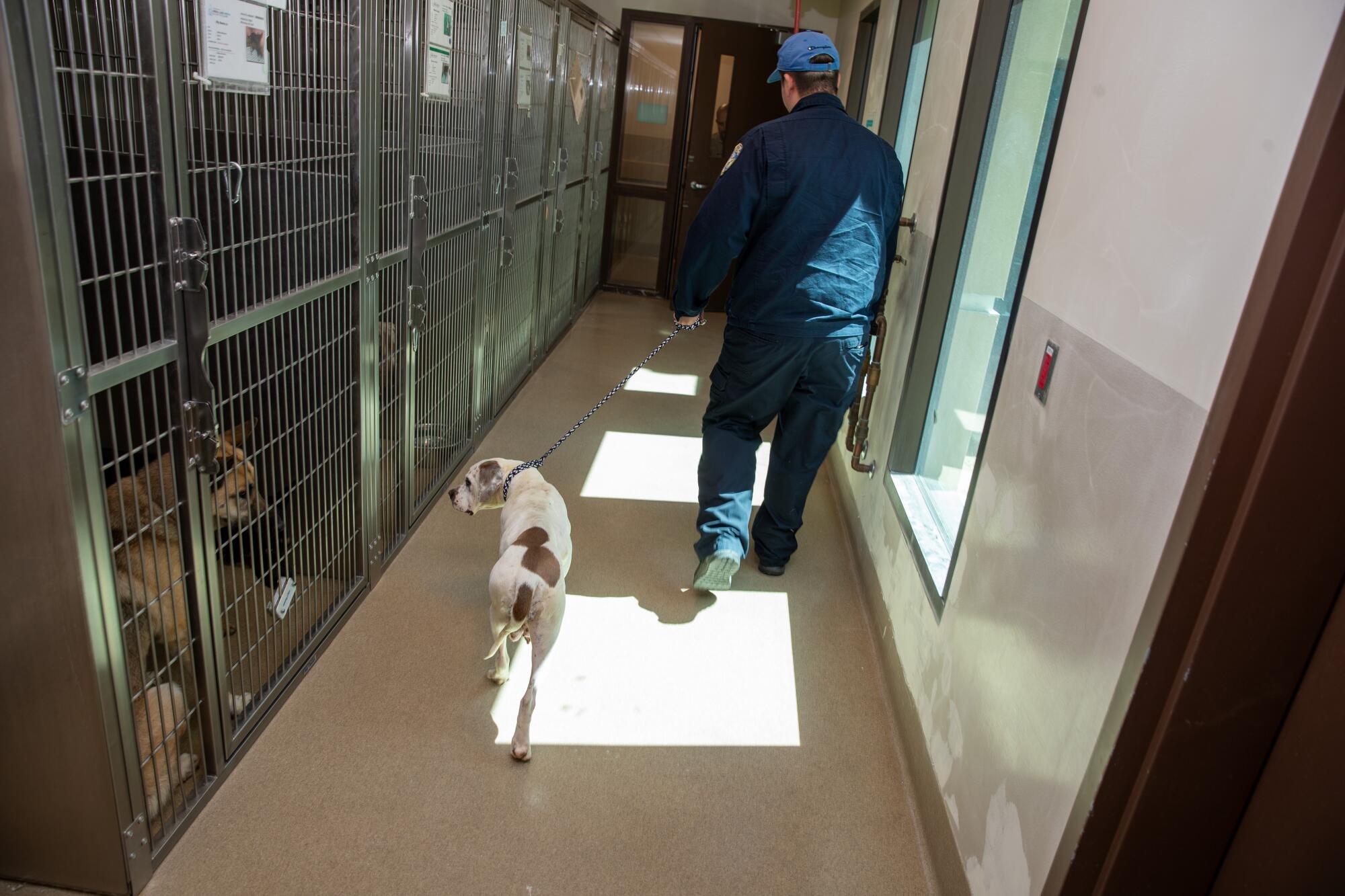
The Palmdale and Lancaster statistics are especially striking compared with those in the city of L.A., which has six shelters with dog euthanasia rates that range from 3% to 11%.
Animal shelters are dealing with an influx of dogs and cats since the pandemic lockdown, and the overcrowded conditions are leading to higher euthanasia rates.
The L.A. County Board of Supervisors has pressed the Department of Animal Care and Control to reduce euthanasia at its shelters. But department director Marcia Mayeda said in a June report to the board that severe staffing shortages were hampering efforts to provide basic animal care and bring down euthanasia numbers.
Animal shelters are dealing with an influx of dogs and cats since the pandemic lockdown, and the overcrowded conditions are leading to higher euthanasia rates.
The Palmdale and Lancaster shelters euthanized 1,576 dogs in the first eight months of this year, accounting for 60% of those put down at the county’s seven shelters.
“We’re so understaffed at both care centers that I can’t say that one is markedly better or worse than the other,” Mayeda said in an interview. “They’re both really suffering.”
Department records show that more dogs are being euthanized across the entire county shelter system because space is limited and there aren’t enough being rescued or adopted to compensate for those coming in.

Visitors look over lists of available animals at Los Angeles County’s Palmdale Animal Care Center. (Brian van der Brug / Los Angeles Times)

Fliers describe dogs available for adoption at Palmdale Animal Care Center. (Brian van der Brug / Los Angeles Times)
At the Palmdale shelter in particular, limited public access to kennels may be a factor. Most dogs are kept in an area that the public can visit only with a staff or volunteer escort. People wanting information about dogs available for adoption can view a corkboard pinned with the animals’ photos, but those are often dark or of poor quality. The time from when dogs enter the shelter until they’re euthanized for lack of space or interest is briefer than at other shelters, The Times found.
The Times analyzed documents obtained through public records requests on more than 14,600 dogs euthanized since 2018 in the seven shelters operated by the county — which has contracts with 45 cities to provide animal care and control services. The reasons cited for killing the dogs were that they were too sick or injured to treat, or too dangerous to be safely adopted; that there was not sufficient kennel space to house the animals; and that there was no interest from potential adopters.
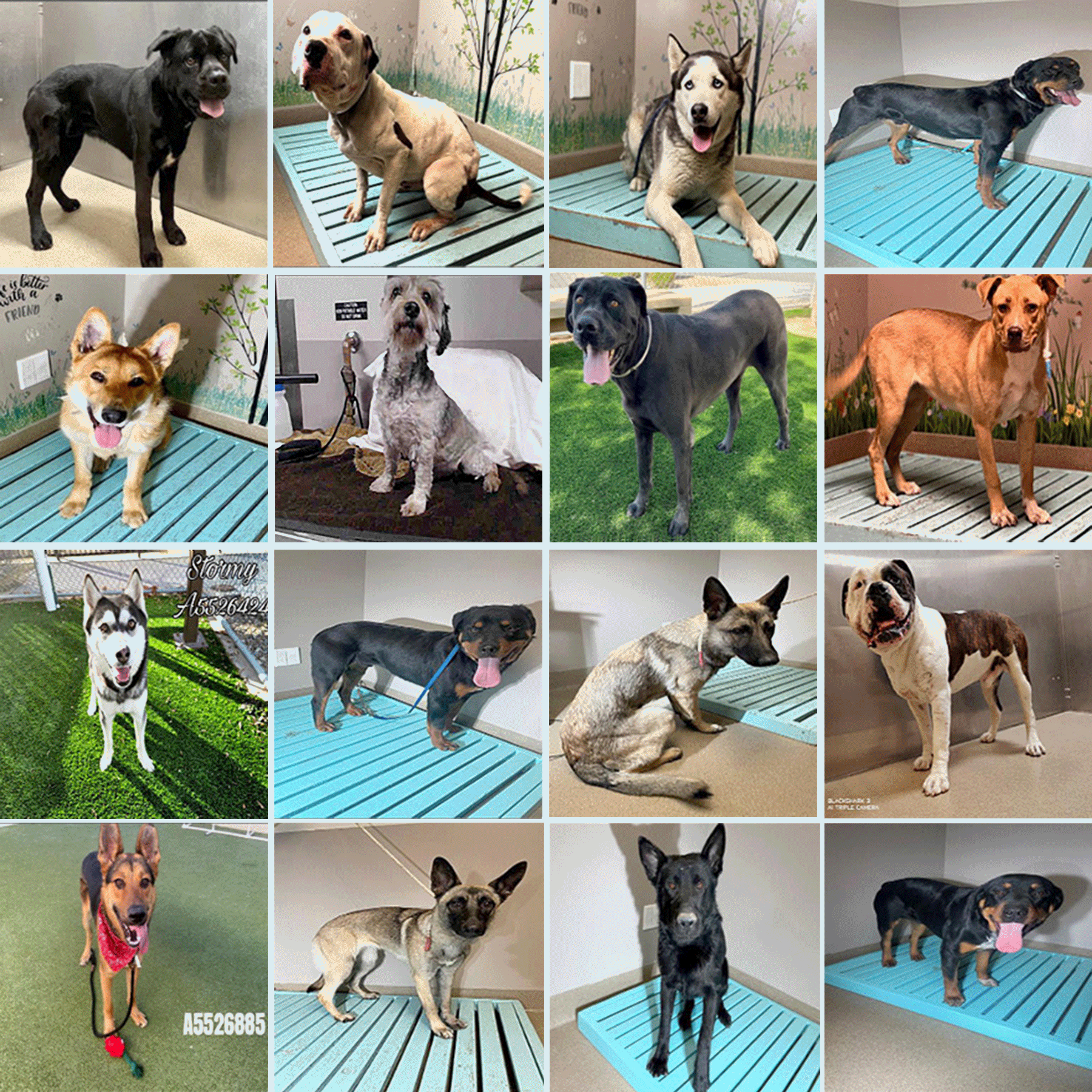
The Palmdale shelter euthanized 981 of its 3,429 impounded dogs last year, and is on track to reach those numbers again this year: Through August, the shelter had put down 765 of the 2,694 dogs that had entered.
Lancaster has surpassed last year’s figures, having euthanized 811 of 2,895 dogs that came in through August of this year. Last year, it put down 738 of the 3,718 dogs impounded.
The two shelters each took in more than 330 dogs a month on average through August this year, making them the highest-intake county shelters.
Under department policy, euthanasia cannot be performed while the facility is open to the public without explicit permission, unless the animal is injured or suffering. Time stamps on records reviewed by The Times appear to show that euthanasias were performed during those hours for nonmedical reasons at most county shelters.
Palmdale and Lancaster, in particular, consistently entered time stamps that appear to show animals were being put down during public hours — some months, dozens of times — since the shelters reopened for walk-ins in May of last year. The number of euthanasias performed during those hours at the Baldwin Park shelter could not be determined because many of its time stamps were missing from records.
Animal Care and Control Deputy Director Raul Rodriguez said that veterinary staff often update computer records after completing all procedures, so the time stamp may not accurately reflect the time of euthanasia. He said he could not say for certain when the procedures were carried out in specific cases.
Department records also show the two Antelope Valley shelters failed to follow their own department’s process to enlist help from rescue groups before putting a dog down. But the guidelines have been haphazard and have evolved.
For example, it has long been the department’s practice to ask those organizations whether they can take dogs that are most at risk.
But only in January did the department adopt a policy requiring shelters to reach out to rescue groups. And a department spokesperson said it was not until February that shelter staff members were briefed on the new requirement.
Now, Mayeda said, “if there is an error, it would be an anomaly.”
The Times reviewed a number of cases at the Palmdale and Lancaster shelters that showed no indication that rescue requests were made. The paper’s request for complete records of such rescue requests for all of the county shelters is pending.
Mayeda said she could not recall any disciplinary actions against staff at the Palmdale or Lancaster shelters based on not complying with the new policy.
In April, Mayeda instructed shelters to send three requests to rescue agencies before an adoptable dog is put down.
::
Babs and Bugs were two stray Belgian Malinois picked up Jan. 21 and kenneled together at the Palmdale shelter.
The 1-year-old dogs were euthanized less than two weeks later, recorded one minute apart during walk-in hours, to make room for other dogs coming in, according to shelter records.
The shelter did not send out rescue requests, known as “pleas,” for either dog even though Palmdale’s behavior team had approved the two for adoption — with restrictions, according to the records. Bugs was required to go to an adults-only home with no other dogs, Babs to one with no children under high school age.

Rodriguez, who oversees three northern L.A. County shelters, including Palmdale and Lancaster, said Babs and Bugs were euthanized because they showed behavioral problems during their time in the shelter, lunging at other dogs through their cages and then each other.
Some experts who work with rescue dogs argue it’s unfair to judge a dog’s behavior in a loud, stressful shelter environment, saying it doesn’t reflect how it would do in a loving home.
“To me, the easy way out is to euthanize — and I think that is unacceptable,” said L.A. County Supervisor Kathryn Barger, whose district includes the Antelope Valley.
She added: “I think that we need to hold administration more accountable,” and “rather than react, be more proactive” in saving animals.
Restrictions adopted during the pandemic to reduce overcrowding prioritized the intake of dogs that were sick, injured or dangerous to the public, Rodriguez said. He said euthanasia decisions are made at weekly meetings among top shelter officials, including members of the behavior, medical and management teams. They review a list of dogs and make decisions based on how long they’ve been housed, as well as their behavior and medical history.
He attributed the higher euthanasia rates at the Palmdale shelter to its small size: It has 68 dog kennels, but through August this year had taken in more dogs than larger shelters, including Baldwin Park, which has more than 190 dog kennels, and Downey, which has 180.
Department officials said more dogs than usual were coming into the Lancaster shelter, which has 176 kennels — blaming the influx partly on the closure earlier in the pandemic of the Mojave shelter about 30 miles away in Kern County. Strays that once would have been taken there are now being brought to Lancaster, they said.
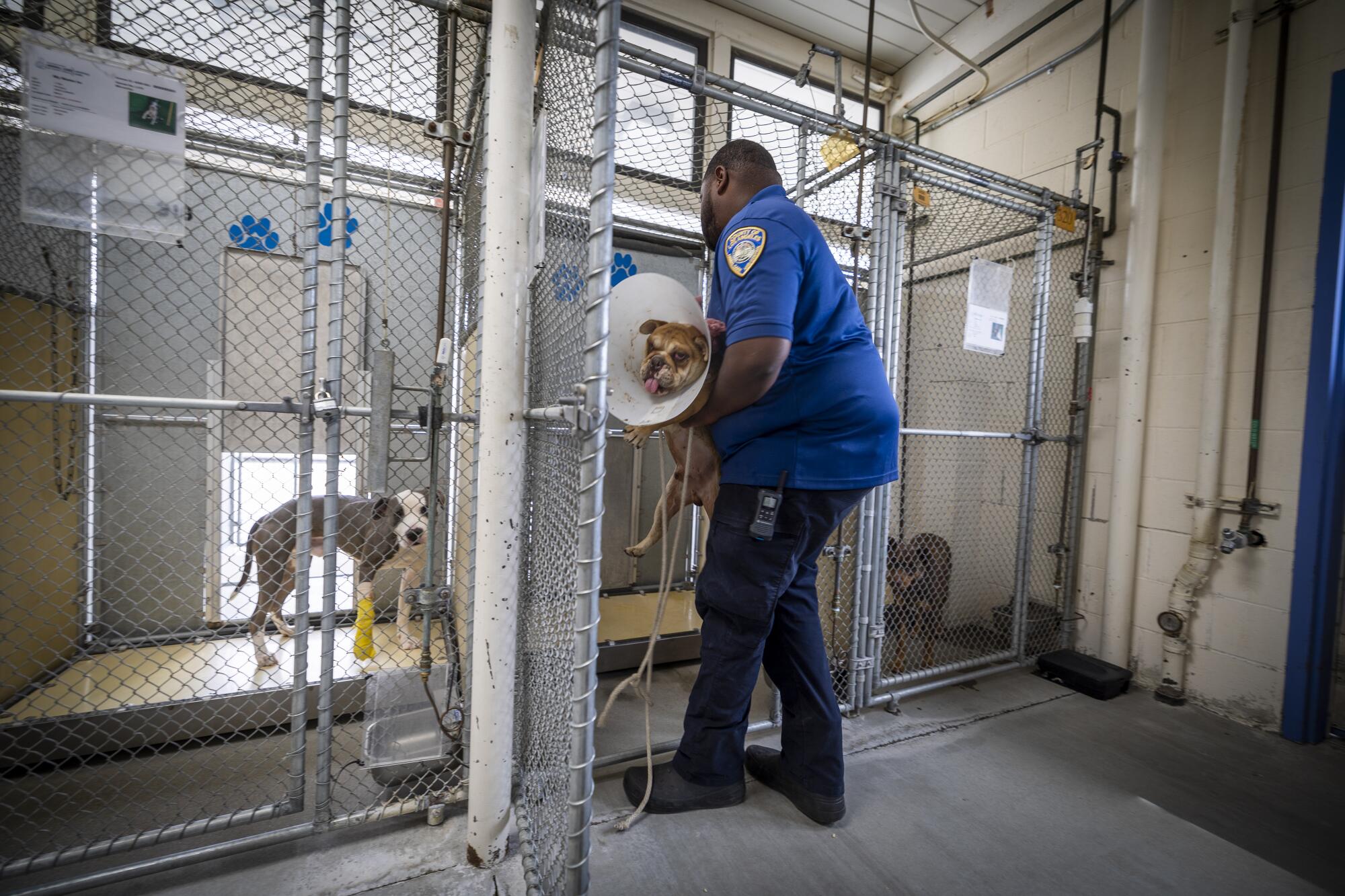
The number of dog deaths at the Palmdale shelter has angered some local officials, who also complained about a $400,000 increase last fiscal year in county charges to manage shelter and animal control services. The city’s total annual budget for shelter services ended up at $1.4 million.
Palmdale city officials earlier this year brought in two animal shelter consulting firms, Animal Arts and Team Shelter USA, to provide recommendations on how to better serve the community, including what it would take to open a new city-owned shelter or pet resource center.
Their report, provided to Palmdale officials in September, has not yet been released publicly.
“It’s hard to stomach, to pay so much money to euthanize,” Palmdale City Councilman Austin Bishop said earlier this year. “The cost is going up every year, and services keep going down.”
::
When it opened, the Palmdale facility — equipped with all indoor kennels, a spaying and neutering clinic, a grooming room and turf play yards outside — was hailed as a model for other shelters.
“I want everyone to know that we’re gonna do 100% adoption. ... Our goal is to really have a ‘no kill at all’” shelter, Barger said at the facility’s one-year anniversary event.
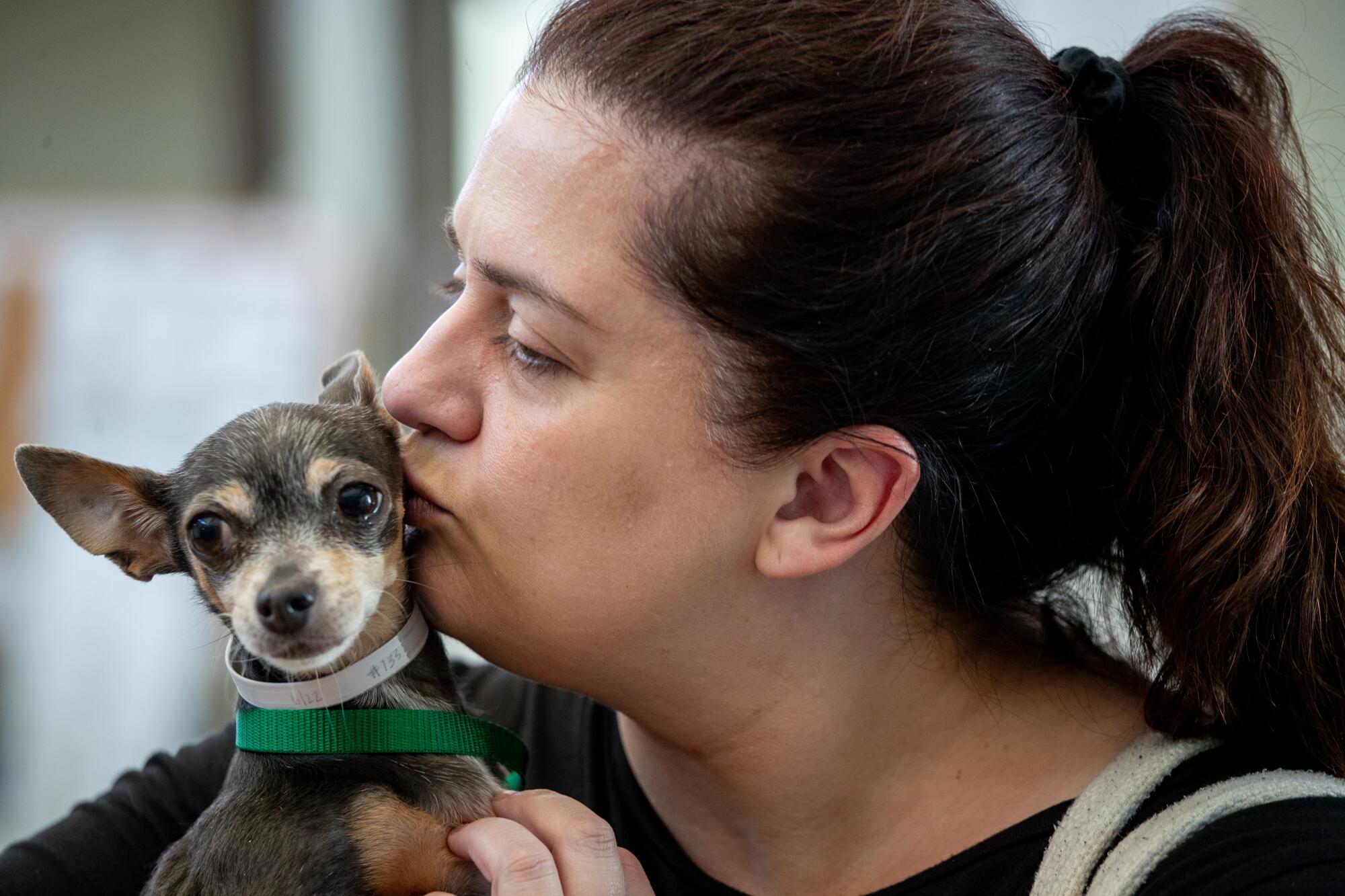
Benavidez, who in addition to working with rescue groups is also a shelter volunteer, said that is far from how things have turned out.
“It’s a death camp there,” she said.
Patricia Saucedo, a longtime Palmdale resident, was one of the shelter’s first volunteers. She now “networks” dogs, posting their photos, videos and personality descriptions online to help find them homes.
She remembers Palmdale’s promise and the expectation that preceded it.
“It really just kind of backfired,” Saucedo said, criticizing the shelter’s design and size. Too many dogs are hidden away behind too many doors, and the shelter is understaffed, she said.
As of June, there were 13 animal control attendants, animal control officers and clerks at the Palmdale shelter and 18 in Lancaster. But county animal welfare officials said in a report that month that the two shelters would need more than triple the number of staff in the next five years to reduce euthanasia.
According to the report, Palmdale would need 39 more staff positions and Lancaster 44. The rest of the county shelters are similarly short-staffed, the report said.
Mayeda, the county animal department’s director, said she did not expect the board to approve all of those positions.
“They asked me what I needed, and this is what we need,” she said, adding that they’ll do their best with what they have. She said that the euthanasia rate in the Antelope Valley is still lower than it was more than a decade ago in 2010.
The county purchased about six acres from Palmdale to build the shelter, but used only a fraction of the land for the $20-million, 25,500-square-foot building, one of the smaller of the seven shelters. Much of the land sits unused.
After The Times began asking questions about the Palmdale shelter’s euthanasia rates, the Board of Supervisors passed a motion, written by Barger, asking that the department look into expanding the facility, saying its limited housing capacity was inadequate to serve the region.
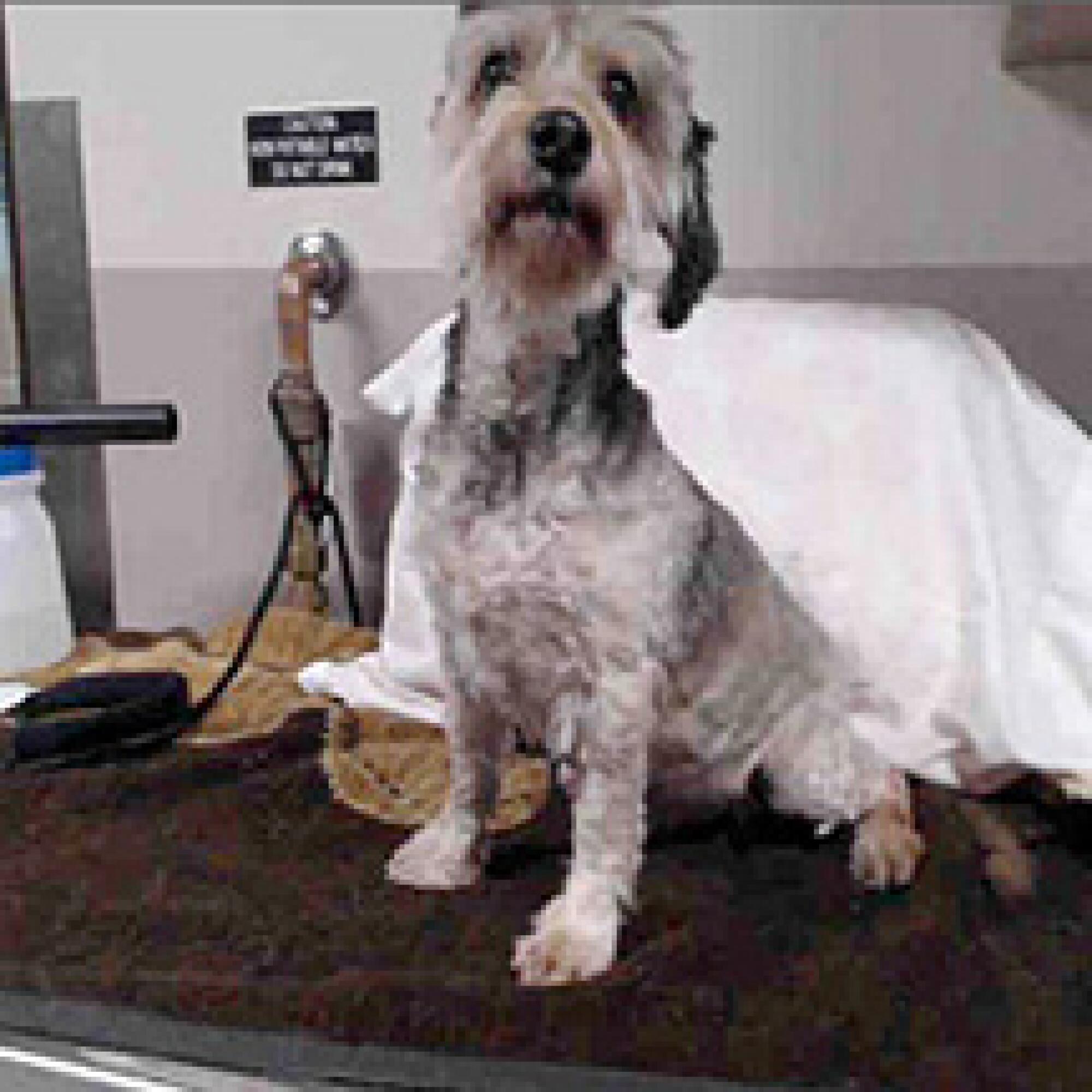
Saucedo recalled an early case that, for her, caused concern about euthanasia decisions: Star, a 7-year-old terrier with one ear, was surrendered to Palmdale in June 2018 by her owner.
“This little lady is Palmdale Shelter’s longest resident,” Saucedo wrote on her Facebook page, Paws of Sunshine, about seven weeks later. “Super sweet, mellow and affectionate. She’s a bit shy when you first meet her, but once you spend some time with her and give her some love, you can see what a happy girl she truly is.”
She paired Star’s description with photos and a video of a small, scruffy terrier jumping up onto a bench to sit beside her for chest scratches.
An hour before the post published, Star had been euthanized for her behavior, according to shelter records, which said she was fearful and noted several instances when she tried to bite staff.
Saucedo thought Star had been timid, but not aggressive.
She was stunned that Star was put down, she said, because she seemed so adoptable.


Two of the many dogs of all ages that have landed at the Lancaster Animal Care Center. (Allen J. Schaben/Los Angeles Times)
::
Some rescue groups, volunteers and animal advocates say the shelter system’s public visiting hours can discourage prospective adopters. Before August, the seven county facilities were open for appointments and walk-ins only a certain number of hours each day. Visitors are now allowed to walk in from 11 a.m. to 5 p.m. Monday through Saturday, but shelters are no longer open Sundays or on Wednesday evenings for prospective adopters who work during typical business hours, something Mayeda attributed to staffing shortages.

But the operating hours don’t fully explain why euthanasia rates are higher at the Antelope Valley shelters.
Kery German, the city of Palmdale’s public safety supervisor, says some of the difference may be due to the nature of the dog population in the area. She and others who work with shelters said shepherds, huskies, bully breeds and other large dogs that have bigger litters are more popular in rural Antelope Valley communities than in city centers.
Those rural areas also have become dumping grounds for unwanted animals from elsewhere. That, German said, along with irresponsible backyard breeders and owners who don’t have their pets fixed, results in more homeless animals. The city has started a low-cost spay and neuter program to help remedy the problem, and since June last year has altered about 1,400 animals.
“The responsibility doesn’t lie just with the animal shelters and the animal rescues,” she said.
Data from the county’s Department of Animal Care and Control show pit bulls and German shepherds are the most common breeds put down at most county shelters — and they’re euthanized at even higher rates in the Antelope Valley.
In May 2022, a senior animal services department staff member complained to top officials about kill practices in Palmdale and Lancaster, including the euthanization of dogs for what were cited as behavioral reasons, according to an email reviewed by The Times. The staffer did not respond to requests for comment.
“I’ve noted that Palmdale and Lancaster have a disproportionately large amount of euthanasias labeled as behavior,” the senior staffer wrote, adding that they had decided to look more closely at the numbers for those shelters. “I find it to be significantly concerning.”
The staff member wrote that a “large amount of animals” are either never assessed or are approved for public adoption but then euthanized for behavioral reasons. The staffer created a list of 58 animals, a majority of them dogs, euthanized at the two shelters from February through April 2022.
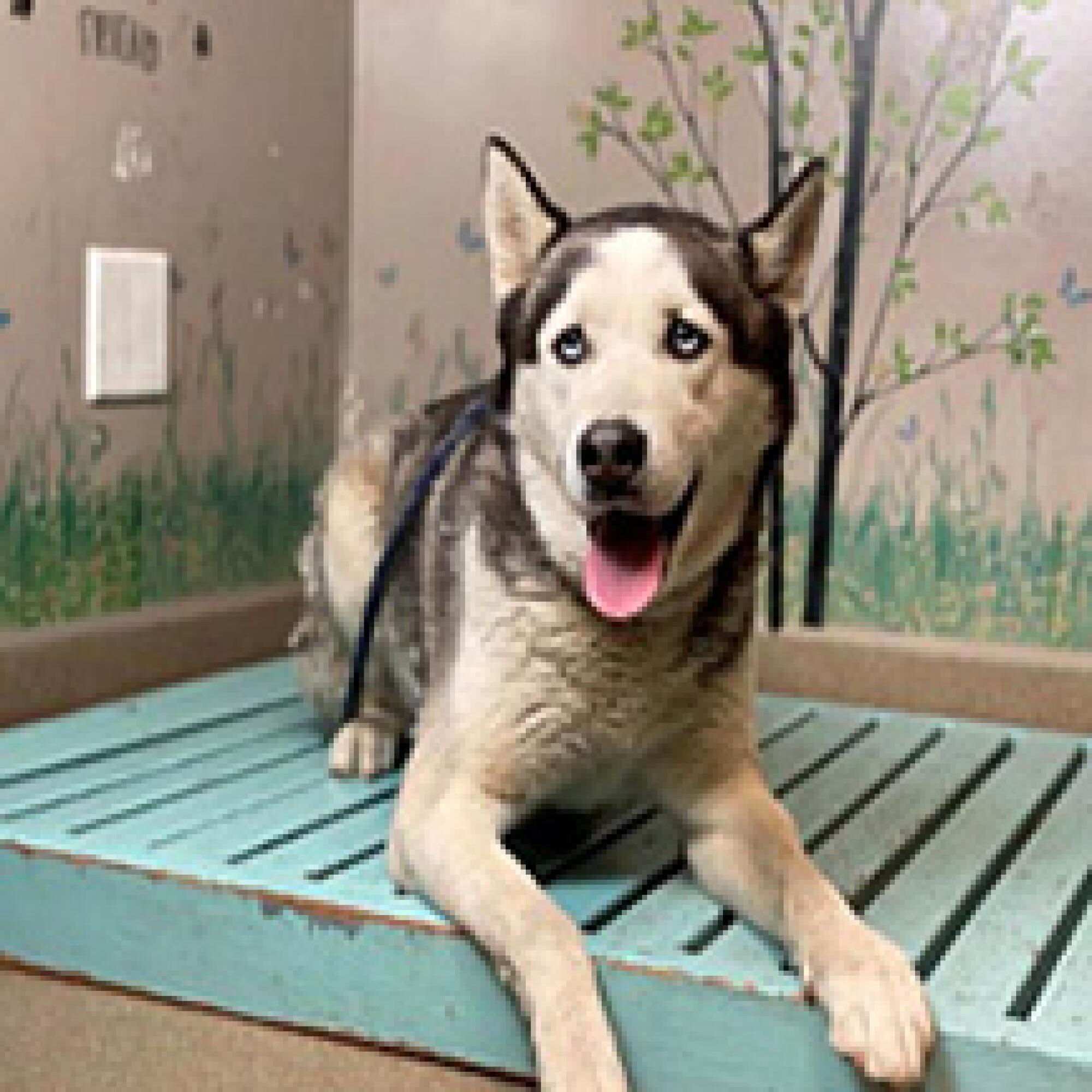
One of those dogs, a gray and white Siberian husky named Tundra, had been approved for public adoption with no restrictions, but Palmdale shelter records indicate he was euthanized due to aggressive behavior, with no requests sent to rescue groups on his behalf.
The department’s behavior team described him as tense around other dogs but friendly with handlers, and medical staff wrote that he did not appear aggressive.
“Fearful tense did ok going slow NO signs of aggression,” a veterinary technician wrote the day he came in.
Rodriguez, the department’s deputy director, said Tundra could not be kenneled with other dogs and the shelter was full, so he was euthanized.
Asked about the staff member’s email, Chief Deputy Director Danny Ubario, Mayeda’s second in command, said that both shelters were at capacity at the time and that dogs were put down for a “combination” of reasons, though the records system only allows a single justification to be entered.
“We did look at it,” Mayeda said of the staffer’s complaint. “I don’t think that there [were] any errors or mischaracterizations or misuse of the system.”
The number of dogs euthanized due to a limited number of kennels has increased in Palmdale and Lancaster. Department records show the Palmdale shelter put down more than 330 dogs last year due to space constraints or because all other options to find them homes had failed — the most at any shelter. The shelter had already surpassed that number as of August this year.
In Lancaster, the number of dogs euthanized for those reasons was on track to more than double — from 231 for all of last year to 422 through August of this year, the records show.
One of them was Blue, an 11-month-old mutt with white socks and pointy ears. In February, networker Danielle Vogt sent an email to the Lancaster shelter about Blue and another pup for whom she hoped to find foster homes.
Blue was euthanized at the Lancaster Animal Care Center.
Increasingly anxious after not hearing back for a week, Vogt decided to foster Blue herself. That’s when she learned Blue had been euthanized a day earlier. No rescue requests had been sent on Blue’s behalf.
Devastated, Vogt alerted Barger’s office. Shelter staff explained the oversight by saying that Vogt had provided the wrong animal ID number in her inquiry.
“We recognize that we can do better based on what transpired with Blue,” Ubario wrote to her, adding that the shelter had put into place a new protocol to better monitor emails.
Kristin Loch, who works at a rescue in the Santa Clarita Valley, said she fields calls daily from owners who need help giving up their dogs.
She typically sends them to county shelters in Castaic or Agoura rather than to the Palmdale location despite the longer drive, because the dogs will have a better chance of leaving the shelter alive, she said.
The Times identified several dogs featured at adoption events or online that were euthanized within days.

In February, the Palmdale shelter posted three photos on Instagram of Stormy, a 1½-year-old Siberian husky with black-and-white fur who had entered a month earlier because her owner was moving.
Two days after the post went up, Stormy was euthanized, according to department records. The reason given: unable to place.
::
Since January, county shelters have been required to reach out at least once to rescue organizations for most dogs facing euthanasia. The policy change came after Bowie, a 4-month-old terrier at the Baldwin Park shelter, was put down without any rescue requests, sparking outrage from many rescue groups and the public.
Earlier this year, state Assemblymember Bill Essayli (R-Corona) introduced a bill named after Bowie that would have required California shelters to provide at least a 72-hour public notice on their websites before euthanizing adoptable animals. It did not pass, but Essayli said he plans to reintroduce similar legislation.

The inconsistency of the plea system has frustrated some rescue workers, who say the Palmdale shelter doesn’t always indicate which dogs are in most urgent need.
The German shepherd Teo, for example, entered the shelter the first week of January. On Feb. 4, the shelter sent out what was marked a “1st rescue plea” in an email to rescue groups, which suggested others would follow.
Teo was euthanized three days later.
Rodriguez said the dog had been on his second round of medication to combat a contagious upper respiratory infection, and that factored into the decision to put him down.
Benavidez has volunteered at the Palmdale and Lancaster shelters since 2017, walking and playing with animals, introducing dogs to potential adopters, cleaning kennels and preparing food.
She had been monitoring Angel, a 2-year-old black German shepherd, who was kenneled in the back at the Palmdale shelter, in an area that required an escort.
She said she expected to see a rescue plea, but it never came. She later learned he’d been euthanized because there was no longer space for him.
Benavidez wasn’t the only one who’d wanted to save Angel. The person who turned him in told shelter officials her mother would adopt Angel if he became a candidate for euthanasia, according to department records.
Shelter records don’t mention efforts to contact the woman or her mother, whose names were redacted.
Rodriguez said it was erroneous to assume from the records that no outreach had been made, but also acknowledged that any attempt to reach the family would have been noted.
He added that Angel’s behavior — he had lunged at other dogs and had to be kenneled alone — factored into why a rescue request wasn’t sent for him, even though the behavior team had approved him for adoption.
The Times also found mistakes in several emails from the Palmdale shelter to rescue groups and networkers and on its website — including deadlines listed that had already passed or dogs marked with the wrong identification number or breed.
One email was marked as both a second and third plea, and the deadline to save the dogs had come and gone two days before it was sent out. Another message included a photo of a 1½-year-old black pit bull, but described a 7-year-old Siberian husky.
Rodriguez said the Palmdale shelter has had to rely more on public adoptions because overburdened rescue groups are pulling out fewer dogs than before the pandemic. According to figures provided by the department, groups rescued 303 dogs from Palmdale in 2022, compared with 898 dogs in 2018.
Sixteen kennels at the facility, though freely accessible to the public, are behind a door, next to a sign that says “Dog adoptions,” and visitors may not realize they can enter.
That was the case on a July afternoon, when Kayzanique Palms and her brother came to the shelter hoping to interact with the pups but left thinking they could only see photos of its dogs. They didn’t know until a reporter told them that there were two rows of kennels they could walk through behind the marked door. The rest of the kennels require an escort.

Pickles, the German shepherd puppy who was euthanized on Valentine’s Day, was in one of the publicly accessible kennels when Benavidez first saw him. Shelter staff had recommended in his file that he be placed in a home with no other dogs, though Benavidez saw him kenneled with another dog in the shelter with no apparent issues. She remembered worrying that a note like that would deter adopters.
She emailed the kennel sergeant, asking when time would be up for Pickles and another dog as she hastened to find them homes.
In an email exchange reviewed by The Times, the kennel sergeant, Nelson Gonzalez, said that Pickles had already had a rescue plea sent out and that he’d been featured as pet of the week by the Board of Supervisors.
“He didn’t give me a direct answer,” Benavidez said. “They put the dog down the next day.”
Gonzalez did not respond to a request for comment.
In California, the Hayden Act, a set of animal welfare laws approved in 1998, requires that in most cases a shelter must release a dog to a rescue group that has requested it, rather than putting it to sleep. Benavidez said she wasn’t given that opportunity.
A department spokesperson said that because the networker never asked for more time or said she had someone ready to take Pickles home, and because the facility was full, the dog was put down.
“That one really killed me, because I felt like there was something that I could’ve done, but they didn’t really give me a chance,” Benavidez said.
George LeVines, The Times’ deputy director for data and graphics, contributed to this report.
More to Read
Sign up for Essential California
The most important California stories and recommendations in your inbox every morning.
You may occasionally receive promotional content from the Los Angeles Times.

